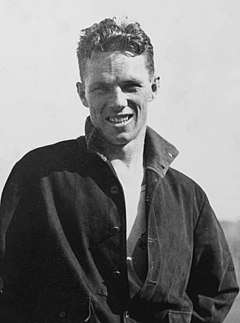James Carlton (athlete)
James Andrew "Jim" Carlton (10 February 1909 – 4 April 1951) was an Australian sprinter. He competed in 100yd and 220yd events at the 1928 Summer Olympics, and was eliminated in quarterfinals.
 Carlton in 1932 | |
| Personal information | |
|---|---|
| Full name | James Andrew Carlton |
| National team | Australia |
| Born | 10 February 1909 Lismore, New South Wales, Australia |
| Died | 4 April 1951 (aged 42) Waitara, New South Wales, Australia[1][2] |
| Spouse(s) | Enid Alison Symington[1] |
| Sport | |
| Country | Australia |
| Sport | Sprint |
| Club | Botany Harriers, Sydney |
| Achievements and titles | |
| National finals | national 100 m and 200 m titles (1931–33) |
| Olympic finals | 1928 |
| Personal best(s) | 100 yd – 9.6 (1930) 200 m – 20.5 (1932) 400 m – 48.3 (1931)[2][3] |
| Updated on 22 January 2016. | |
Schoolboy star
Carlton was born in South Lismore and was educated at Marist Brothers schools in Lismore, Darlinghurst Sydney and then at St Joseph's College, Hunters Hill where he was a schoolboy and GPS sprint champion. In both years 1925 and 1926 he won the New South Wales Amateur Athletic Association 120 handicap yd handicap event, the Catholic schools championship and the New South Wales junior title.
In his three senior years at the St Joseph's College from 1925 to 1927 he set GPS records in the 440yds (three successive records and three victories); the 220yds (two successive records and three victories) and the 100yds (one record and three victories).[4] Carlton first came to the sporting public's notice as a schoolboy in 1927 running the 100 yds in 10.0 s and the 220 yds in 21.8 s both those records stood for twenty-nine years. In March 1927 just turned eighteen, he won the New South Wales senior state titles for 100 and 220 yds.[5]
Senior athletic career
At the end of 1927 and just out of school, he ran as the New South Wales representative at an Australasian Games in Wellington and won the 100yd and 200yds events. He joined the Botany Harriers Athletics Club in Sydney and then won three successive national championship sprint doubles (100 yds and 200 yds) in 1928, 1930 and 1932 when the championships were only held every two years. He competed at the 1928 Olympics in Amsterdam but was run out in the quarter-finals, his form affected by illness (quinsy).[6] Though selected for the 1930 British Empire Games, Carlton did not run.[7]
In 1931 Carlton equalled Eddie Tolan's world record for 100 yards of 9.4s but the record was disallowed as the time had only been taken on two stop watches.[8] His 9.6 national record, set in 1930, stood for twenty-three years.[1]
His 20.6s run to win the 220 yards national championship at the Sydney Cricket Ground in 1932 created a sensation, smashing the world record (then 21.0s), and was controversially judged as wind assisted. The judge reportedly used a piece of wood to ascertain the wind speed and his decision was disputed by observers present at the time. The Carlton's time was surpassed only after the Second World War.[5][9]
Priesthood
In 1932 Carlton retired from athletics and entered a Catholic seminary in order to become a priest; a move that meant he could not compete at the 1932 Olympics.[10][1]
Marriage
Carlton left the priesthood in 1945. He married Enid Alison Symington, of Chatswood, a stenographer, at Chatswood on 10 April 1945.[11][12][13] They had two children: Mike (1946-),[14] the well-known Sydney radio broadcaster, and Peter (1950-), who became a human resource manager.
Later life
He then worked as a school teacher at Barker College and in 1948 was appointed as a selector and coach for the New South Wales Amateur Athletic Association. In parallel he wrote sports articles for the Sydney Morning Herald.
Death
He died of asthma on 4 April 1951, aged 42, at his home in Waitara, Sydney.[15][16][17][18][1][5]
References
| Wikimedia Commons has media related to James Carlton. |
- James Brock Rowe. "Carlton, James Andrew (1909–1951)". Australian Dictionary of Biography, National Centre of Biography, Australian National University
- Jimmy Carlton sports-reference.com
- James Carlton. trackfield.brinkster.net
- Cerise & Blue magazine 1927
- E. L. Quercetani and G. Pallicca (2006) A World History of Sprint Racing 1850–2005. SEP Editrice. p. 57. ISBN 8887110751.
- Olympic Runner Ill, The (Adelaide) News, (4 September 1928), p. 9.
- James 'Jim' CARLTON (NSW). Athletics Australia
- Anthony Barker (2000). What Happened when: A Chronology of Australia from 1788. Allen & Unwin. pp. 236–. ISBN 978-1-86508-426-8.
- Progression of IAAF World Records (2011) Imre Matrahazi (ed.), IAAF Athletics, pp.40 and 462.
- Jimmy Carlton: To Study for Priesthood: Great Athlete Retires at Height of Success, The Catholic Press, (Thursday, 28 January 1932), p.17.
- Athlete Retires From Priesthood. Marries, The (Sydney) Daily Telegraph, (Friday, 17 August 1945), p.5.
- Left Priesthood to Marry, Smith's Weekly, (Saturday, 18 August 1945), p.3.
- J. Carlton Left Priesthood For Marriage, The Sydney Morning Herald, (Friday, 17 August 1945), p.10.
- "Jimmy" Carlton Now A Dad, Smith's Weekly, (Saturday, 20 July 1946), p.1.
- Deaths: Carlton, The Sydney Morning Herald, (Friday, 6 April 1951), p.18.
- Jim Carlton, 42, dies at his home, The (Sydney) Sun, (Thursday, 5 April 1951), p.1.
- Funeral of Jim Carlton, The (Sydney) Sun, (Friday, 6 April 1951), p.2.
- Fund Opened, The (Bathurst) National Advocate, (Saturday, 9 June 1951), p2.